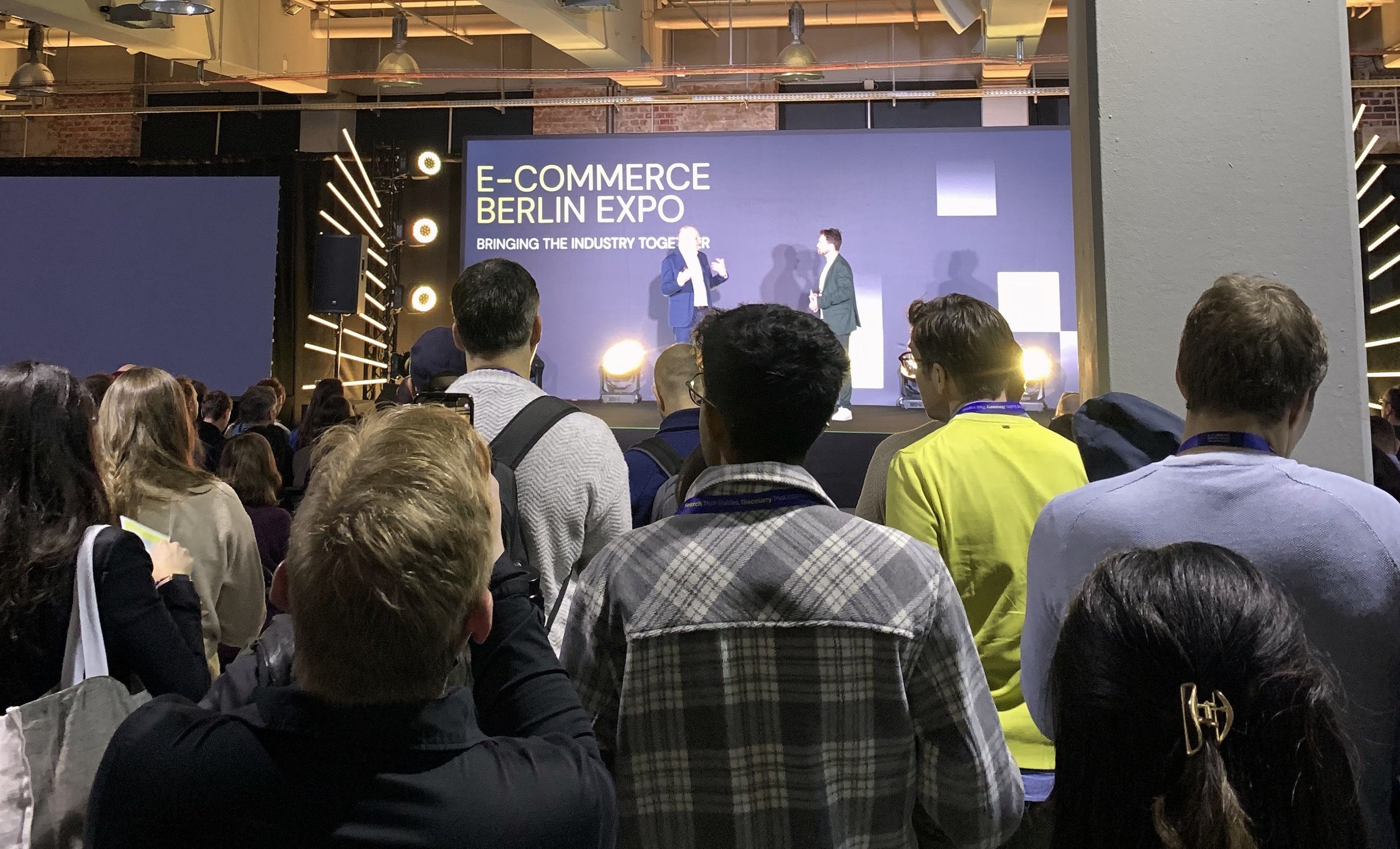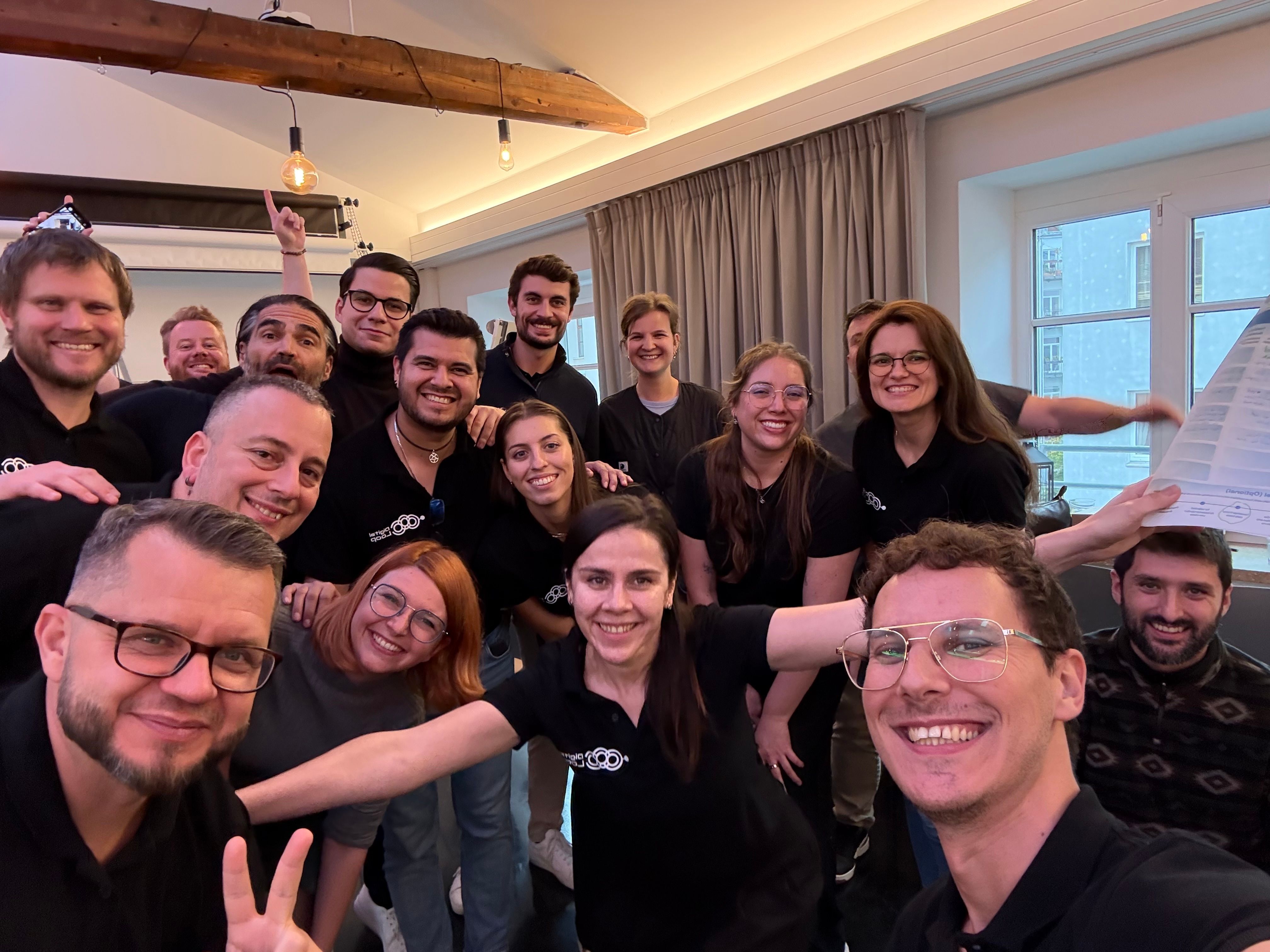The Berlin Ecommerce Expo 2025, held in a sprawling hall near Gleisdreieck, was a jolt. It was buzzing from sheer energy both inside and outside. Even the frosty -9 degrees did not stop the Berliners from standing outside to get in. The queue was so long you were practically in it the moment you stepped out of the U-bahn Gleisdreick. But the lines moved steadily and I got in within half an hour with my printed ticket.
That day, I was so keen to discover how these giant enterprises utilize AI and craft their strategy to achieve success. I expected the event to be exciting and innovative, but I did not expect the magnitude of it. The moment you got in, the hall and the crowd swallow you. The panels practically took place in four different corners, and as four different panels took place at the same time, I was forced to run from one hall to another every time one ended, passing various booths with interactive displays such as popcorn machines to claw machine, to secure a good seat. The bustling expo wasn't just an event; it was a business showcase. I basically ran laps of over 7000 steps being there for just the first day, as the halls where the panels were held are located on the four different corners of the venue.
The first session gave the perfect background, explaining the stark contrast of the investing environment between the US and Europe. The US, with its larger, unified market, aggressive investment culture, and fewer regulatory constraints, fosters an environment of rapid scalability and innovation. In contrast, Europe's fragmented landscape, stringent GDPR regulations, and more cautious investment approach create a unique set of challenges and opportunities. This fundamental difference formed the backdrop for every case study and insight I gathered, shaping the strategies and innovations showcased. The expo wasn't just an event; it was a snapshot of the future, a future where AI's potential is both exhilarating and demanding, and where understanding these market differences is crucial.
How The Enterprise Leverages AI
The secret sauce is simple: they know how to leverage data and thus they know how to optimize their strategy. Every company’s representative who stood at the podium that day has perfected their skills over and over again. They don’t just build one roadmap strategy plan, they fine-tune them.
Amongst all the things they leverage AI for, one of the top tier uses is for content. Here’s their formula:
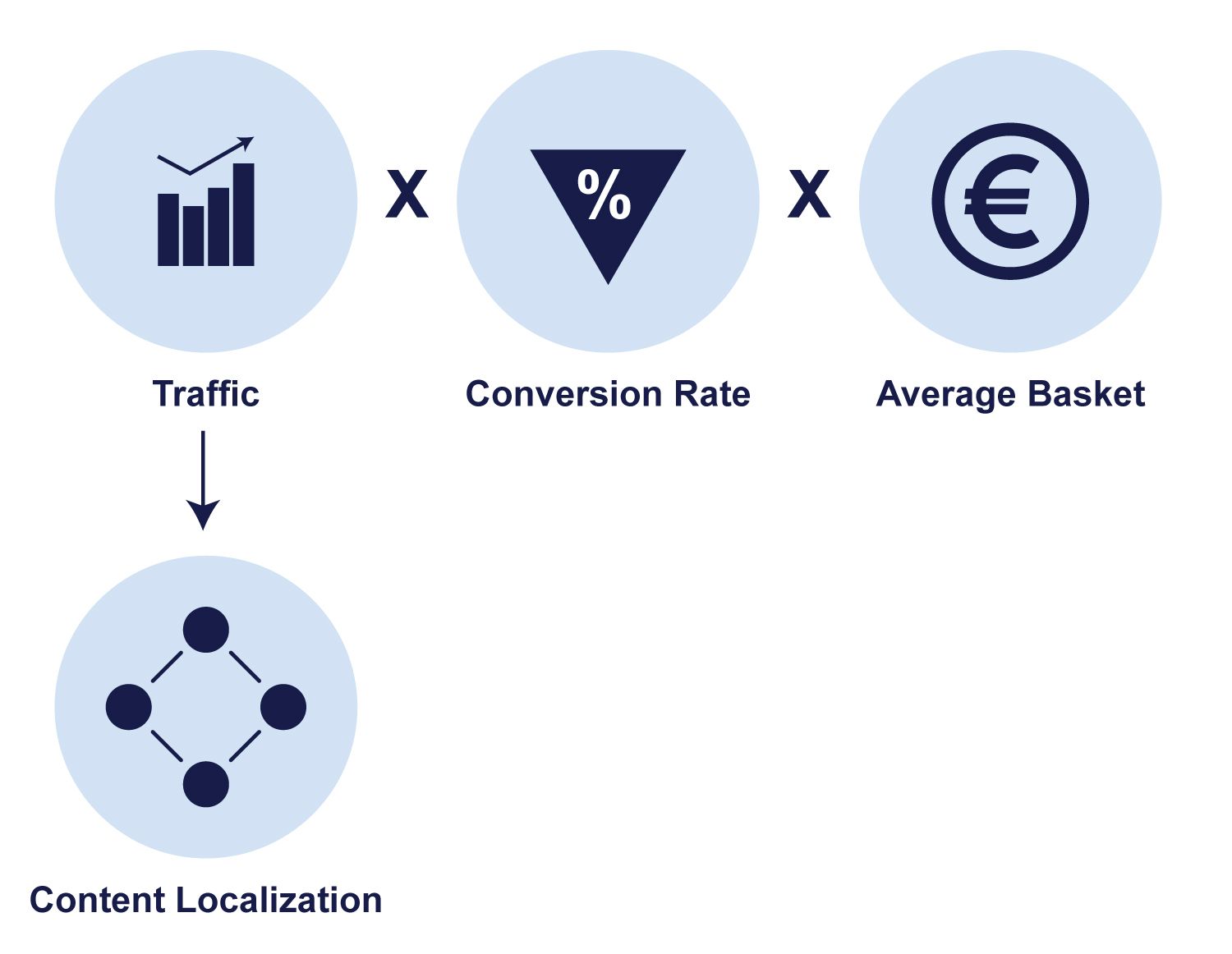
This formula is universal among different industries and is adaptable for this very simple reason: personalization. The chart below explains the pyramid needs of e-commerce customers. In the middle you will see UX and personalization, just right above functional needs. Yes, it is that essential. It’s not a “nice to have” as many people think it is. And exactly here, is where AI is utilized for: personalization. The success formula? Adjusting the creatives/variants for each channel with AI. More details will be presented later below.
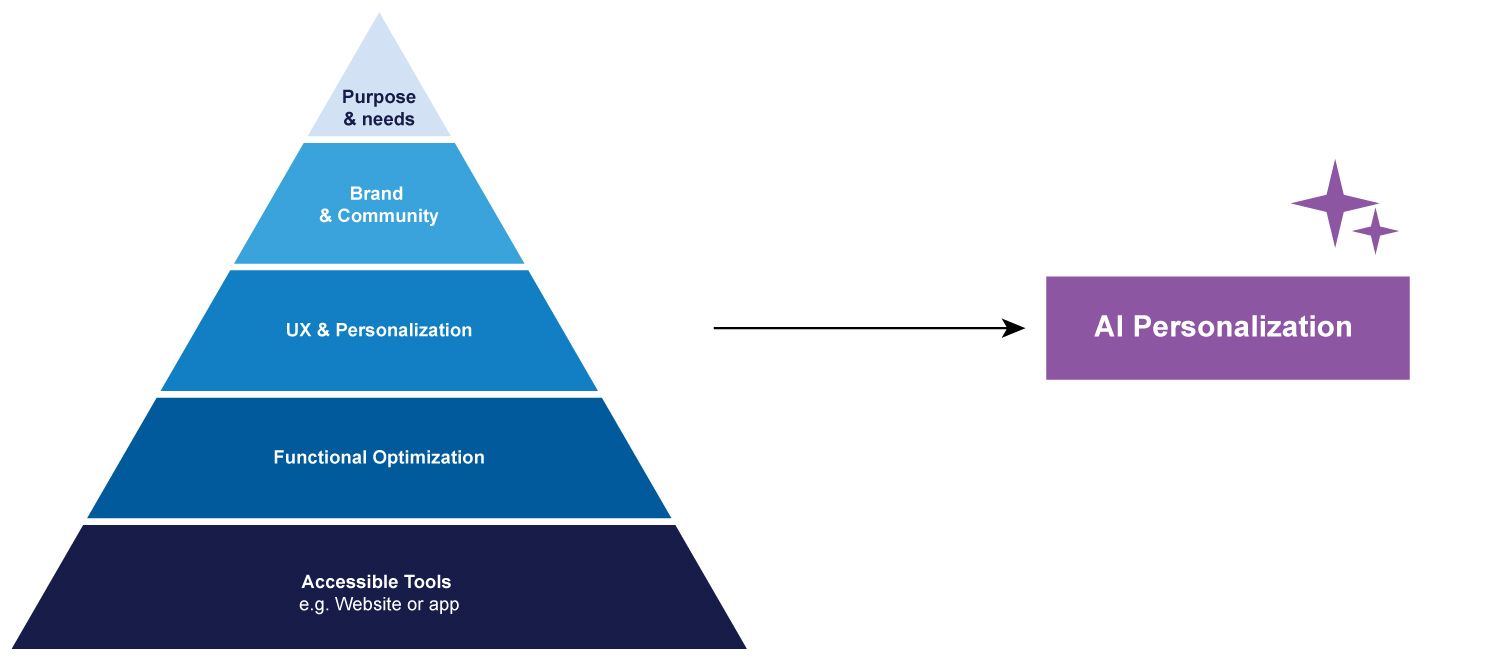
But before we go there, it’s important to note that similar to the investment game, the economic ecosystem in the US and Europe is completely different, and these differences profoundly impact e-commerce marketing strategies and potential scale. Firstly, the U.S. has a vast and relatively unified domestic market. This allows American companies to achieve significant economies of scale in marketing campaigns, messaging, and logistics – a stark contrast to Europe's fragmented landscape of diverse languages, cultures, and national regulations which often translates to country-specific approaches, increasing complexity and cost. Reaching 300 million potential customers with a single core strategy is fundamentally different from needing multiple strategies for a similar aggregate number spread across 27+ distinct markets.
Furthermore, the investment culture diverges significantly. U.S. businesses, particularly within the tech and e-commerce sectors, are often fueled by a more aggressive growth mindset and have historically enjoyed greater access to venture capital. This translates into a willingness, and often the necessity, to invest heavily and speculatively in marketing upfront to capture market share rapidly. Shortly speaking, investment culture is more emphasized. Adding another layer to this, U.S. companies often take a broader view of "marketing capital," more readily incorporating the value of intangible assets like brand equity and accumulated customer data into their strategic financial calculations, potentially justifying higher marketing expenditures aimed at building these long-term assets.
Conversely, the European market operates under a different regulatory philosophy, exemplified by stricter data privacy regulations, notably GDPR. While the US has its own evolving privacy laws, GDPR imposes significant restrictions on the collection, processing, and usage of customer data for marketing purposes. This directly impacts the feasibility and effectiveness of certain data-driven marketing strategies common in the US, requiring European marketers to often find alternative, sometimes less direct, ways to achieve personalization and targeting.
These fundamental differences in market structure, investment appetite, asset valuation philosophy, and the regulatory environment create distinct playing fields and shape the very nature, scope, and tactics of successful e-commerce marketing in each region.
A Thousand Copies on Valentine’s Day: Omio/Cassi Pro
It’s exactly as it said: Omio used Cassi Pro to generate a thousand creatives overnight for their Valentine’s Day campaign. With AI, this is nothing extraordinary. However, the devil is in the details. The million-dollar question is: How did they do it, and what strategy lies behind it?
In case you haven’t heard of them, Omio is a travel platform. They allow users to compare and book trains, buses, boats, and flights across Europe and beyond. It provides a seamless way to plan trips by integrating multiple transport options into one easy-to-use service. Seeing that their market is international, it’s understandable that they would need a thousand copies in multiple languages. It’s not only a matter of language; it's a matter of localization. Each country has a different view and approach on Valentine’s Day. It’s about those differences in nuances, instead of a mere translation in multiple languages of one master copy.
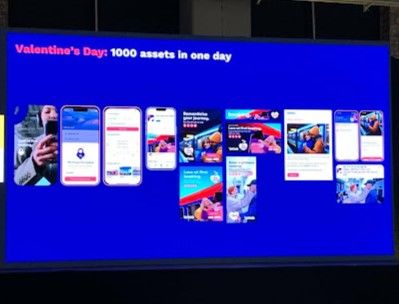
(Example from the global TikTok: LINK)
So now, the million-dollar question: how did Omio generate 1,000 pieces of localized content in just one day? The answer lies in leveraging AI beyond simple content generation. As we discussed earlier, AI-driven personalization is key, and Omio applied this principle at scale.
Instead of manually crafting each creative, they integrated AI with their existing data sources to automate and scale content production efficiently. Companies like Cassi Pro and Omio use AI-powered API tools, which act as bridges between data and content creation. These APIs enable seamless access to real-time data, allowing AI to generate dynamic, contextually relevant marketing content automatically. This is especially valuable in Europe, where data silos and regulatory constraints can pose challenges—making AI-driven scalability even more crucial.
Omio specifically used an API tool for large language models (LLMs), connected via a plugin, to streamline content workflows. This automated the generation of highly personalized marketing creatives, helping them produce 1,000 localized pieces for Valentine’s Day alone. Additionally, with the ChatGPT operator, they automated small but essential tasks like filling out alt text, further optimizing productivity.
Omio’s approach highlights how AI, when integrated strategically, can transform marketing operations—scaling creativity, reducing manual work, and improving efficiency.
Weinfreunde: Leveraging UX Data to Fine-Tune Strategy
Weinfreunde's case study focused on the importance of localization and data-driven UX. Their strategy emphasized the use of data analysis to make informed design decisions based on user behavior and optimize the user experience for higher conversions. They demonstrated the power of content localization, highlighting how adapting market-specific content can significantly improve results.
Data-driven design plays such a crucial role in omnichannel marketing as it enables companies to make informed decisions based on data analyses. By using data from different channels, brands can comprehensively understand their customers’ behavior and preferences.
This means for every decision they make, they don’t only do best practices. Personally, also in SEO, “best practices” is not this glorified encyclopedia that has all the answers your heart desires. The moment you open this book, it will say “it depends”. This is where a lot of people get stuck. This is where relying on data and drawing hypotheses accordingly might be the make or break for a company.
Let’s keep it concrete and dive into a practical example. During the conference, they demonstrated how they assess their website’s overall user experience—examining how users navigate the shop, how they feel about the process, and identifying areas for improvement. A key goal is to evaluate the effectiveness of their user research and determine whether users are satisfied with the results. The main pain points they are scrutinizing relate to friction in key interactions, specifically the shopping cart, registration, and checkout process. These three elements define critical stages in the user journey: experience, discovery, and checkout. After gathering data, they test different scenarios in their lab. Based on these experiments, they formulate a hypothesis and adjust previously used parameters accordingly.
Here are the data sources they rely on:
- Point of sales sources - market-based information
- Traditional Excel Sheets
- Market research
- Webshop surveys
- After-sale information of different markets
- UX/UI: driving test scenarios in lab tests
- Power BI: canalizing sales from webshops
Similarly, they also apply this strategy offline, specifically on the spot in their physical shops. They once spent two years fine-tuning the strategy they use for the small wine stand placed in Rewe, on a special stand for Christmas. They tried different types of messages and displays. Such as a monitor that displays different messages to promote their special wine selection. After two years, they found out that the best strategy is actually a simple message. This is a small example but perfectly demonstrates how they take even such a small stand in their offline store seriously, seeing the effort they have made to fine-tune the strategy.
Burger King's Whopper Campaign
I consider this a bonus, but this might demonstrate the best creative use of AI for a campaign among the other cases. The Burger King "Whopper AI" campaign stands as a prime example of innovative marketing that leverages artificial intelligence to generate both consumer engagement and valuable user-generated content (UGC). In this contest, Burger King challenged customers to create their ultimate Whopper burger, offering a grand prize of $1 million for the winning recipe. Participants could submit their creations through the BK app or website, selecting up to eight ingredients. The magic happened when Burger King's AI engine transformed these culinary concepts into reality, generating a mouthwatering image preview of the custom burger, complete with a stylized background and a catchy jingle. So what is so genius about this? It’s about how it generates UGC. The created recipe is basically an ad. But even better, a shareable ad. It needs one click to be free ads running free and turning participants into BK’s brand ambassadors, effectively turning their customer base into a creative marketing force. This campaign demonstrates the type of bold, consumer-engaging marketing that is frequently seen in the US market.
Key Takeaways
The Berlin E-commerce Expo 2025 offered a compelling glimpse into the future of e-commerce, revealing the central role of AI in strategies employed across diverse business niches. From Omio's hyper-localized Valentine's Day campaign to Burger King's UGC-fueled Whopper contest, the prevailing themes were clear. Here are the strategies in common that I found across different business niche panel presentations:
- Leveraging AI for scalable content automation and personalization: Creating highly targeted and engaging experiences for individual customers.
- Striving for a centralized, data-driven platform to streamline operations: Integrating data sources and automating workflows to improve efficiency. This includes removing or reducing menial, time-consuming tasks using AI.
- Innovating on traditionally complex processes: Using AI to simplify complex and redundant processes/tasks such as tax compliance and customer service.
- Continually refining the customer journey based on user behavior: Employing data-driven UX optimization to address friction points and improve conversion rates. Remember that the journey does not stop at creating a great product page! It goes on until the cart and checkout process.
However, the Weinfreunde case also serves as a crucial reminder that traditional marketing channels retain significant value, and the temptation to abandon offline elements entirely should be resisted. Looking ahead, data ethics and responsible data sharing will become increasingly paramount, especially within the stringent regulatory landscape of the European market. Ultimately, success in this evolving landscape requires a balanced approach: embracing AI's transformative capabilities while remaining grounded in human insights, ethical considerations, and a deep understanding of the unique challenges and opportunities presented by the European market. Remember that every challenge also presents an opportunity.

